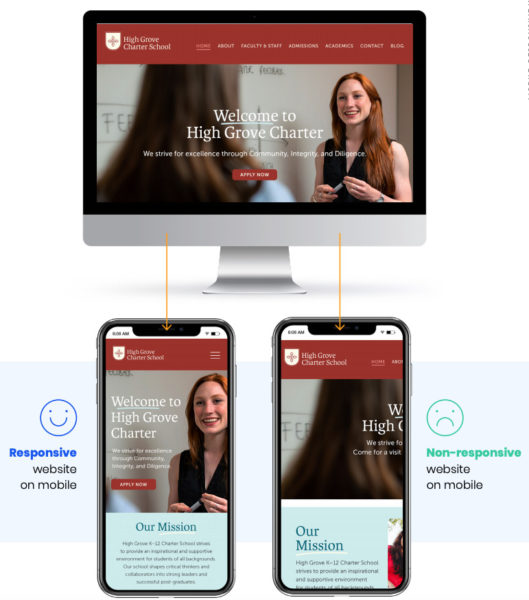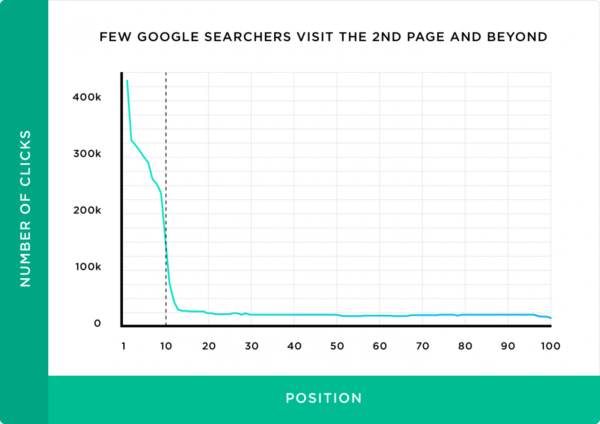
Running a school means constantly reaching out and growing your community. It’s part of the nature of education — students graduate or transfer, and you need new students to take their place. But how do you find those students and families who will thrive in your community?
Can’t you just show the world who you are and let them come to you?
Well, yes and no. Families who search for private schools will come to you, but you have to be where they’re looking — namely, online. If someone looks for “private elementary schools in Springfield” or “Catholic high schools in Chicago,” and you fit that category, you need to have an online presence that shows what you offer.
These private school marketing techniques can help you achieve that goal. In the paragraphs to follow, you’ll learn how to create a professional, informative website that communicates what your school is all about.
In this post we’ll cover:
- The importance of branding
- Creating a mobile-responsive website
- Managing your listings and reviews
- Getting started
The importance of branding
When you’re trying to attract new students to your school, it’s important to communicate the feel of your school community across every platform that you use. The marketing world refers to this as “branding,” and for you, that means creating a consistent visual aesthetic that represents your school’s character.
If you’re not sure what your brand is, think about what’s most important to your loyal families and students. What attracted them to your school? Why do they stay? If you’re not sure, ask. Their values are probably similar to those of the families who would consider enrolling in the future.
Once you have an idea of the atmosphere you want to convey, choose a color palette and font to use across all of your marketing.
Creating a mobile-responsive a website
Your school website is the most important element of your private school marketing strategy. It’s the central hub where all of your efforts will lead people, so you want to make sure it’s comprehensive, informative, and a reflection of who you are as a community.
Every private school website should start with the following six core pages:
- Home page
- About page
- Faculty and staff page
- Admissions page
- Academics page
- Contact page
Depending on what type of school you have and what you offer, you might want to add more pages. A boarding school, for example, will probably have a residential life page, and a religious school might want a page about the core beliefs. Across all of your pages, keep your colors and other branding elements consistent.
Finally, make sure your website loads quickly on any device and that it’s optimized for mobile devices. Mobile-responsive websites adjust their layout based on the device type so that when someone browses your site on their phone, it’s just as easy to read and scroll.

Mobile responsiveness is an important part of marketing your school to students. According to a survey by Common Sense Media, more than half of all children in the U.S. own a smartphone by age 11, and 19% have one by age 8. By the time kids hit high school, 81% have phones, and the percentages go up from there.
Optimizing for search engines
Most of your families will be searching locally, so make sure you mention the location of your school in your website content. Don’t force it, but work it in where it makes sense:
“St. Joseph’s Academy is a K-12 Catholic school in [town]…”
These local mentions will help you to rank highly in local search results. Schools need to be found easily on Google just as much as any other business, and only 0.78% of searchers click on results beyond the first page. That’s more than 99% of potential families who probably won’t find you unless you’re on page one.

Mentioning your location in your content will help you to appear in local searches, but you’ll also want to claim your Google My Business listing.
A location-based Google search — something like “private schools near me” — will bring up a listing called Local Pack, which features a map with the location of top results pinned. These listings get almost 14% of all clicks on that results page.
To rank in Local Pack, you need to claim your listing. Include your location, contact information, website, and as many pictures as you can manage. Research shows that the more photos you have on your Google My Business listing, the more clicks you can get.
Manage your listings and reviews
Google My Business isn’t the only site that will list your school. It’s also important to have a presence on Yelp and the major school-review sites such as GreatSchools and Private School Review. If you fit into a special category — for example, if you’re a Catholic school or boarding school — make sure you’re listed on sites that serve that niche.
Some sites, like SchoolDigger, don’t take listing requests directly from schools. To get listed there, you need to register for the Private School Universe Survey through the National Center for Education Statistics (NCES). Review sites use the NCES to make sure listed schools are legitimate.
Many listing sites include reviews, and reviews matter to people. Did you know that 82% of people, including 93% of those aged 35 to 54, read reviews for local businesses? Or that among those who read reviews, 97% pay attention to how the business responds?
Responding to reviews
Make sure you respond to all reviews, positive and negative. A short thank-you is fine for positive reviews. For negative reviews, empathize and take responsibility on the school’s behalf. Ask questions to show that you want to understand the situation, and offer to talk offline if that would help.
Negative reviews can happen, so try not to get too upset about one or two. Let them be opportunities to show prospective families how professionally you resolve conflicts.
If you don’t have reviews yet, or if you need a few more, ask select members of your community to contribute. Alumni, parents, and older students with parents’ permission make good candidates. Ask them to provide as many details as possible and encourage them to be honest.
As always, the goal is to show potential families what life is like at your school, so they can decide if it’s the right place for them and their children.
Getting started
By now, you’ve had an in-depth look at how to market a private school. You’ve learned you can design your website so that it has the best chance of getting noticed on search engine results pages, and you’ve learned why it’s important to manage your listings on school review sites. You’re ready to start attracting people to your website.
For more inspiration, check out The Download, Constant Contact’s comprehensive marketing guide for schools. There, you can get ideas for website design and learn how to use other forms of private school marketing, like email and social media. Who knows — one of those techniques could bring your next top student through your doors.




